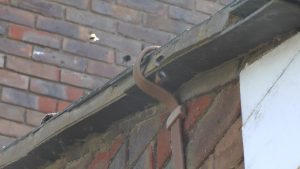Tree bumblebees
by Ian Short
Recently, there have been a load of bumblebees buzzing around outside a crevice in the wall of one the university building. Here’s a snapshot of some of them.
Several bees were flying round in circles outside the nest, while other bees flew in and out, seemingly oblivious to those loitering outside. Eventually, with the help of this article on tree bumblebees, I figured out what’s going on.
Tree bumblebees are recent arrivals to the United Kingdom (first appearing around 2001). They are spreading rapidly, and are not, as far as I’m aware, considered a threat to other bees. They are common on the continent. In the wild they nest in trees, but in towns they often nest in buildings. Most other nesting bumblebees in the UK nest in the ground, I believe.
The queen bee emerges around March from hibernation. She feeds, then finds a nest site. She then produces female worker bees, most of which go off and collect nectar and pollen (same as for other nesting bumblebees). Around the end of May, the queen produces drones (males whose sole purpose is to mate) and new queens. The drones perform a ‘mating dance’ outside the nest – not their own nest – another tree bumblebee nest. When new queens leave the nest, the dancing drones try to mate with her. And so the cycle goes on; some successful queens establish a second colony in the same year, later in the summer.
The drones fly facing the nest (mostly), ready for a queen to emerge from the nest. Sometimes, in their eagerness to mate, drones fly into each other, perhaps believing momentarily that another drone is a queen. They fall to the ground with a thud. A friend witnessed this, but I haven’t seen it. I did see a couple of queens moving in and out of the nest.
